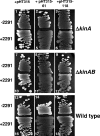Sensor domains encoded in Bacillus anthracis virulence plasmids prevent sporulation by hijacking a sporulation sensor histidine kinase
- PMID: 16923903
- PMCID: PMC1595385
- DOI: 10.1128/JB.00656-06
Sensor domains encoded in Bacillus anthracis virulence plasmids prevent sporulation by hijacking a sporulation sensor histidine kinase
Abstract
Anthrax toxin and capsule, determinants for successful infection by Bacillus anthracis, are encoded on the virulence plasmids pXO1 and pXO2, respectively. Each of these plasmids also encodes proteins that are highly homologous to the signal sensor domain of a chromosomally encoded major sporulation sensor histidine kinase (BA2291) in this organism. B. anthracis Sterne overexpressing the plasmid pXO2-61-encoded signal sensor domain exhibited a significant decrease in sporulation that was suppressed by the deletion of the BA2291 gene. Expression of the sensor domains from the pXO1-118 and pXO2-61 genes in Bacillus subtilis strains carrying the B. anthracis sporulation sensor kinase BA2291 gene resulted in BA2291-dependent inhibition of sporulation. These results indicate that sporulation sensor kinase BA2291 is converted from an activator to an inhibitor of sporulation in its native host by the virulence plasmid-encoded signal sensor domains. We speculate that activation of these signal sensor domains contributes to the initiation of B. anthracis sporulation in the bloodstream of its infected host, a salient characteristic in the virulence of this organism, and provides an additional role for the virulence plasmids in anthrax pathogenesis.
Figures




Similar articles
-
A unique GTP-dependent sporulation sensor histidine kinase in Bacillus anthracis.J Bacteriol. 2009 Feb;191(3):687-92. doi: 10.1128/JB.01184-08. Epub 2008 Oct 17. J Bacteriol. 2009. PMID: 18931112 Free PMC article.
-
Characterization of sporulation histidine kinases of Bacillus anthracis.J Bacteriol. 2005 Oct;187(20):6972-81. doi: 10.1128/JB.187.20.6972-6981.2005. J Bacteriol. 2005. PMID: 16199567 Free PMC article.
-
Structural insights into inhibition of Bacillus anthracis sporulation by a novel class of non-heme globin sensor domains.J Biol Chem. 2011 Mar 11;286(10):8448-8458. doi: 10.1074/jbc.M110.207126. Epub 2011 Jan 7. J Biol Chem. 2011. PMID: 21216948 Free PMC article.
-
Bacillus anthracis genetics and virulence gene regulation.Curr Top Microbiol Immunol. 2002;271:143-64. doi: 10.1007/978-3-662-05767-4_7. Curr Top Microbiol Immunol. 2002. PMID: 12224521 Review.
-
What sets Bacillus anthracis apart from other Bacillus species?Annu Rev Microbiol. 2009;63:451-76. doi: 10.1146/annurev.micro.091208.073255. Annu Rev Microbiol. 2009. PMID: 19514852 Review.
Cited by
-
Two small c-type cytochromes affect virulence gene expression in Bacillus anthracis.Mol Microbiol. 2009 Apr;72(1):109-23. doi: 10.1111/j.1365-2958.2009.06627.x. Epub 2009 Feb 15. Mol Microbiol. 2009. PMID: 19222757 Free PMC article.
-
Effects of experimental exclusion of scavengers from carcasses of anthrax-infected herbivores on Bacillus anthracis sporulation, survival, and distribution.Appl Environ Microbiol. 2013 Jun;79(12):3756-61. doi: 10.1128/AEM.00181-13. Epub 2013 Apr 12. Appl Environ Microbiol. 2013. PMID: 23584788 Free PMC article.
-
The secret life of the anthrax agent Bacillus anthracis: bacteriophage-mediated ecological adaptations.PLoS One. 2009 Aug 12;4(8):e6532. doi: 10.1371/journal.pone.0006532. PLoS One. 2009. PMID: 19672290 Free PMC article.
-
In vivo domain-based functional analysis of the major sporulation sensor kinase, KinA, in Bacillus subtilis.J Bacteriol. 2009 Sep;191(17):5358-68. doi: 10.1128/JB.00503-09. Epub 2009 Jun 26. J Bacteriol. 2009. PMID: 19561131 Free PMC article.
-
A unique GTP-dependent sporulation sensor histidine kinase in Bacillus anthracis.J Bacteriol. 2009 Feb;191(3):687-92. doi: 10.1128/JB.01184-08. Epub 2008 Oct 17. J Bacteriol. 2009. PMID: 18931112 Free PMC article.
References
-
- Arantes, O., and D. Lereclus. 1991. Construction of cloning vectors for Bacillus thuringiensis. Gene 108:115-119. - PubMed
-
- Baillie, L., A. Moir, and R. Manchee. 1998. The expression of the protective antigen of Bacillus anthracis in Bacillus subtilis. J. Appl. Microbiol. 84:741-746. - PubMed
-
- Brittingham, K. C., G. Ruthel, R. G. Panchal, C. L. Fuller, W. J. Ribot, T. A. Hoover, H. A. Young, A. O. Anderson, and S. Bavari. 2005. Dendritic cells endocytose Bacillus anthracis spores: implications for anthrax pathogenesis. J. Immunol. 174:5545-5552. - PubMed
Publication types
MeSH terms
Substances
Grants and funding
LinkOut - more resources
Full Text Sources

